Teaming, adaptability guide field response to COVID-19
By Charlie Cook
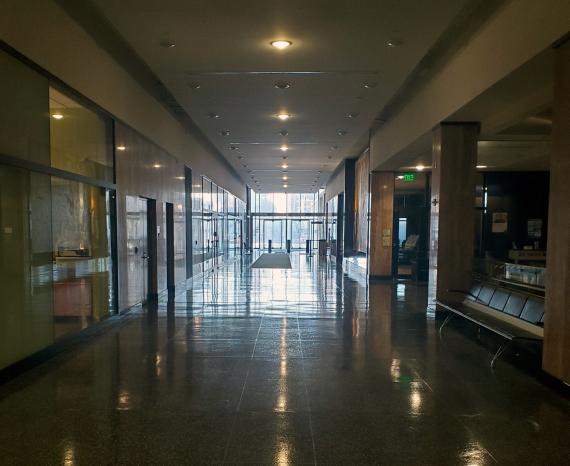
On March 12, 2020, building managers at the Robert J. Dole U.S. Courthouse in Kansas City, Kansas, were notified that a tenant working at the building tested positive for COVID-19. It was the first reported case in Region 6, and the beginning of a learning experience that PBS building managers — and support staff from the regional office — would tackle together.
“When that first call came in, we huddled together virtually and spent probably two and half hours discussing what to do,” said Service Center Division Director Bill McGowan. “I think we had 25 people trying to figure out how to deal with it.”
Incidents of possible and confirmed cases would soon spread to every field office in the region. With tenants turning to GSA for answers, and no playbook to respond, building managers forged ahead.
The initial response
PBS had already assembled a triage team of building managers, branch chiefs and subject matter experts in anticipation of the coronavirus making its way to the region. By the time it arrived, though, guidance was still unclear.
“Out of the gate, there was a lot of anxiety, and there wasn’t enough information at the time to really make decisions with certainty,” said Kansas City North Field Office Director Josh Woods. “We had to determine what we thought was right. That’s kind of the field office life. We have to make decisions before the experts have time to vet everything.”
With each incident, the team would come together and discuss how to respond, how to communicate, and how to document it.
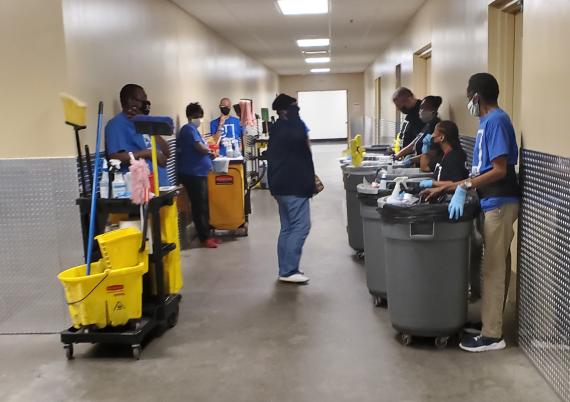
“We were trying to follow all the national guidance, both from the Centers for Disease Control and Prevention and GSA, but it was changing,” McGowan said. “We spent the first month or two really working to establish a process.”
McGowan says building managers were able to find success “by living our PBS values.” (Accountability, adaptability, integrity, intentional decision-making and teaming.) He also credits the work of the Acquisition Management Division for their early efforts in modifying custodial contracts to add enhanced cleaning of high-touch areas.
“It took a couple months, but ultimately the team came together, and we were able to stop the one-off calls,” he said. “We did add an intentional meeting each week to share best practices, listen to each other’s stories, and help establish a rhythm to keep us all working together. By then, people understood they were part of the process.”
Field office directors credit McGowan, Courtney Springer, Javonne Robinson, Ken Greichen (OMA) and representatives from the Facilities Management Divisions — Diane Czarnecki, Chris Bolinger, Dara Lamb and Jeffry Cushing — for guiding the creation of that process and unifying the region’s response.
“Little did we know just how important Diane’s (Czarnecki) role was to the organization,” said St. Louis East Field Office Director Patty Pelikan. “She was a lifeline. She was very responsive. She was there with us the entire time as we waited for national guidance.”
Finding a groove
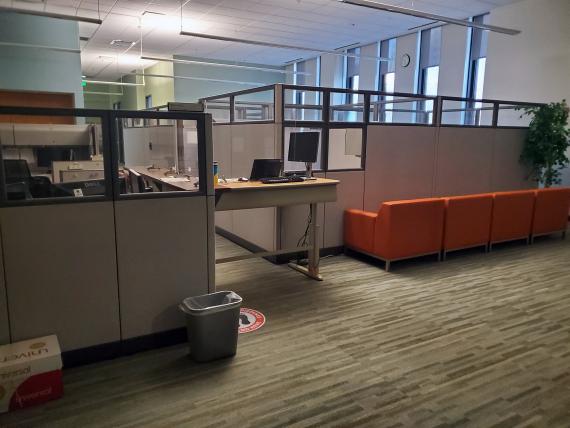
By May 2020, national guidance on cleaning was stabilizing, and proper reporting requirements were becoming more streamlined.
The product of the region’s teaming efforts and working together early on was two flow charts — one for owned buildings and one for leased buildings — that served as guides for building managers when it came to cleaning, communicating and reporting.
According to Bolinger, who acts as a project manager for the regional PBS pandemic response, these process documents were the foundation for the efficiency of the planning efforts.
“Trying to centralize information and share it was critical,” he said. “We were very specific in our efforts to put a team together, and from the beginning we were focused on working together and determining the most effective response process.”
Ultimately, all Region 6 field offices found success through:
- Guiding agencies’ reoccupancy efforts.
- Increasing ventilation and improving filtration in HVAC systems.
- Enhancing regular cleaning and disinfecting high-touch surfaces.
- Adding building signage for social distancing and elevator spacing.
- Installing plexiglass sneeze guards.
- Developing the roles of facility security committees and tenant boards.
“Give our regional office credit,” said St. Louis West Field Office Deputy Director Rocky Boice. “They really jumped on it, and we got that process down. It wasn’t pretty getting there, but we figured it out as a team.”
Being there
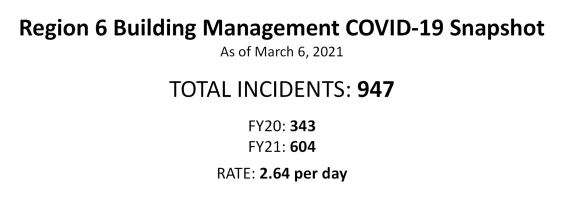
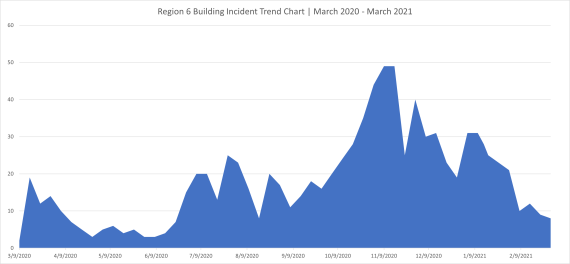
Even before the implementation of maximum telework across GSA, Region 6 leadership directed field office personnel to make the best teleworking decision for their own safety. While other areas of GSA were more practiced working remotely, managing buildings virtually represented a fundamental shift for building managers.
Many of the field offices set up rotations for personnel, limiting on-site staff where possible while still being there for the tenants and contractors.
“Most of our staff continued to do their thing,” said Iowa Field Office Director Diane Strawn. “We had some people go on 100% telework, and that really worked OK. Everyone has been really cooperative. People weren’t complaining.”
Kansas City South Field Office Director Roger Haynes chose to spend the first months reporting to the office before beginning rotations with his staff.
“We talked about getting on a rotation basis. But, after I thought about it, and not really knowing COVID that much, I thought there’s no sense in risking it,” he said. “We also have a prospectus project going on and the Marines continued to be on-site for that. USDA and FEMA never stopped coming in. So, it was important we were there.”
The biggest concern, according to building managers, was ensuring janitorial and operations and maintenance contractors were able to continue performing their work.
“Our O&M and janitorial contractors were concerned about their people,” Pelikan said. “From the start, we were all working to make sure they were able to provide the services we were asking them to provide, and doing it safely. It was important for us to be there for them.”
Moving forward, field office directors agree that having a presence and “being there” is a critical part of their job.
“Lately it seems like reporting and entering data is an increasing part of a building manager’s job, so I could see a scenario where some of that work could be done while teleworking,” said Nebraska Field Office Director Jeff Warinski. “Perhaps a building manager could be at home doing that stuff while others are at the building. But, it’s always going to be important for us to be there.”
Strawn said she’s seen improvement with using virtual meeting technology, and she could understand lease administrators maybe being more flexible with their schedules moving forward, but building managers want to be on-site.
“They are happy to be here,” she said.

 U.S. General Services Administration
U.S. General Services Administration